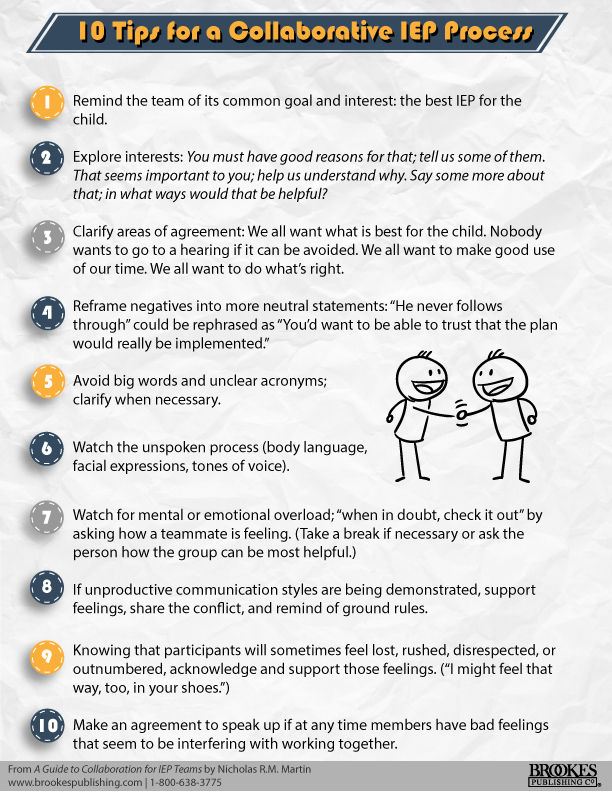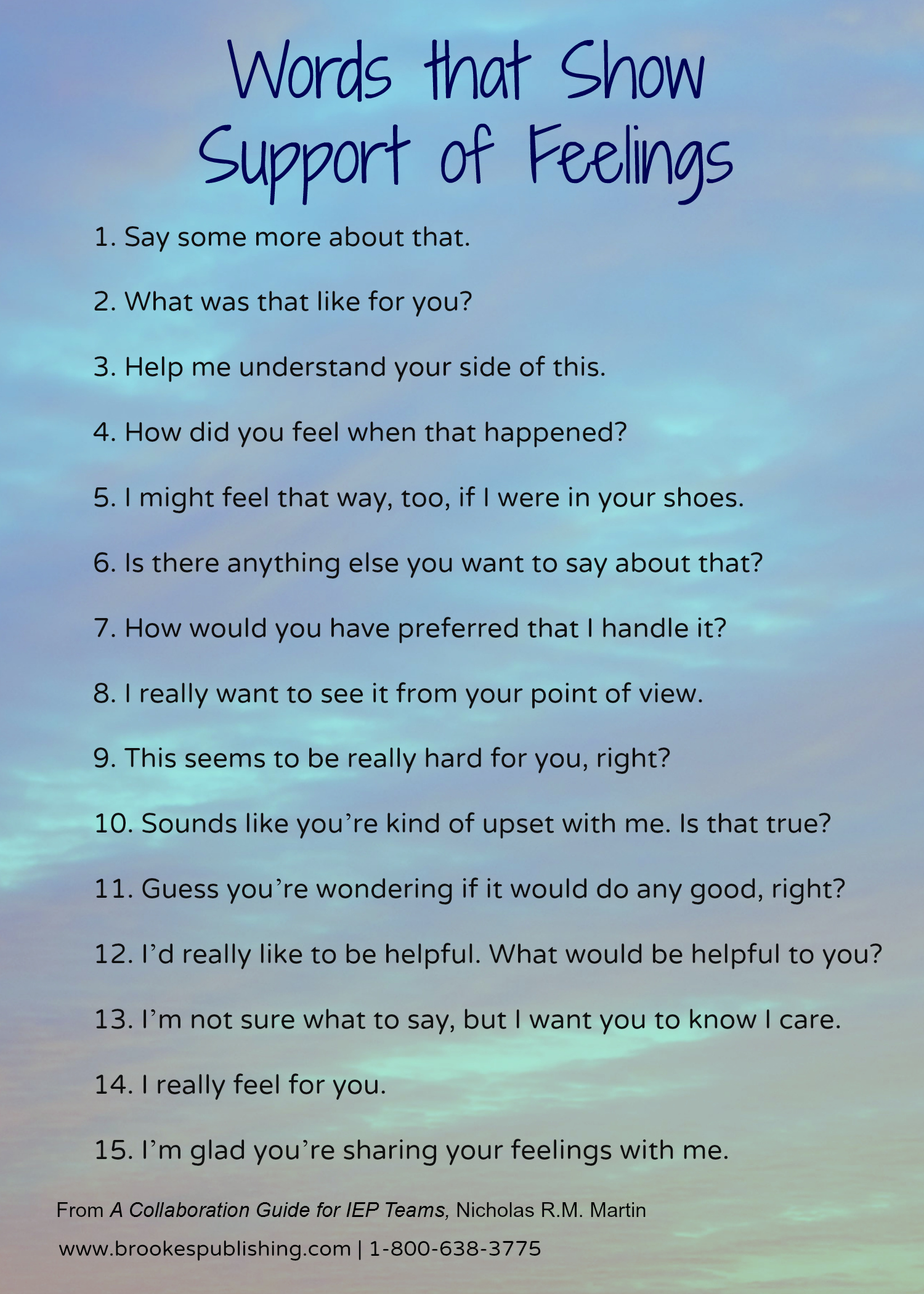10 Conflict-Busters for IEP Meetings
May 16, 2017
Collaborative and productive IEP meetings lay the foundation for better student outcomes—but with so many complicated and emotionally charged decisions involved, the meeting room can feel like a minefield. Before clashing opinions, unspoken resentments, and miscommunications upend your IEP meeting, try these tips from seasoned conflict resolution specialist Nicholas Martin.
In his book A Guide to Collaboration for IEP Teams, Martin offers tons of great strategies for making your collaborative IEP process more peaceful and productive. Ten of his tips are excerpted and adapted below. Use them at your next meeting and share them with your fellow team members as you work together to create A-plus IEPs for your students.
1. Remind the team of its common goal. Everyone at the IEP meeting has the same overarching interest: a well-designed IEP for the child. A quick up-front reminder of your ultimate shared goal can get the meeting off to a strong start.
2. Explore and clarify interests. Sometimes when a team member makes a statement, the emotion or motivation behind it is unclear. Follow up with statements that tease out their good intentions: “You must have good reasons for that; tell us some of them.” “That seems important to you; help us understand why.” “Say some more about that; in what ways would that be helpful?” This communicates caring, interest, respect, and inclusion.
3. Highlight areas of agreement. Establish (out loud) the shortlist of principles you all agree on. For example, every member of the educational team wants what’s best for the child, and nobody wants to go to a hearing if it can be avoided. Every person at the table wants to make good use of the team’s time, and everyone wants to do what’s right, even if there’s not a clear consensus about what the “right thing” to do is.
4. Reframe negatives into neutrals. Try altering inflammatory statements so they’re less judgmental and they don’t point fingers at particular team members. For example, a pessimistic statement like “John never follows through” could be rephrased as “You’d want to be able to trust that the plan would really be implemented.”
5. Clear up jargon and acronyms. If a team member starts using jargon that a parent, for example, might not understand, resentment can start to simmer. Clear up jargon, but be careful not to single the parent out and ask if they need help understanding. Instead, ask for clarity yourself; try saying something like, “Excuse me, I just want to be sure I understand those acronyms the same way you do. Can you rephrase that for me in everyday terms?” or “It would really help me to hear those acronyms in everyday terms. Could I trouble you to repeat that last part again in different words?”
6. Monitor unspoken communication. Be alert not just to the words of fellow team members, but also the other indicators of their emotions and opinions: body language, facial expressions, tones of voice, and even silence. Awareness of nonverbal communication cues can help you recognize your team members’ undercover emotions—and resolve any issues before they escalate.
7. Watch for the beginnings of mental or emotional overload. How are your teammates feeling? Are you sensing some resentments, doubts, or worries that your fellow team members might be stifling? Make your motto “when in doubt, check it out”—try a simple question like “Ms. Smith, are you maybe a little upset with me or something that was said?” It’s better to ask up front so an issue can be worked out before feelings turn from bad to worse. Take a break if necessary, or ask the person to explain how the group can be more helpful.
8. Nip unproductive communication in the bud. If any team members start engaging in negative, unproductive communication styles—rambling, going off topic, belittling—gently refocus the conversation as soon as possible to get the meeting back on track. A reminder of communication ground rules might be helpful, too.
9. Acknowledge feelings and sympathize. At times, participants in IEP meetings will feel lost, rushed, disrespected, or outnumbered. Be sure to acknowledge those feelings and sympathize with team members. A simple statement like “I might feel that way, too, in your shoes” can go a long way toward making everyone feel heard and respected. (See the end of this post for 15 phrases that show support of feelings.)
10. Create an atmosphere conducive to speaking up. Make an agreement that team members can speak up at any time if they have bad feelings that seem to be interfering with working together. For collaboration to be safeguarded, all team members must be free to share, discuss, explore, and participate before the team heads straight for conclusions.
 As Nicholas Martin points out, “nobody wins unless everybody wins” in IEP meetings. Try these suggestions to help make your next IEP a win/win for everyone—and for more in-depth guidance on effective IEP meeting management and conflict resolution, check out A Guide to Collaboration for IEP Teams.
As Nicholas Martin points out, “nobody wins unless everybody wins” in IEP meetings. Try these suggestions to help make your next IEP a win/win for everyone—and for more in-depth guidance on effective IEP meeting management and conflict resolution, check out A Guide to Collaboration for IEP Teams.
SHARE THE TIP SHEET
Like these ideas? Here’s a condensed version in tweetable/pinnable/shareable format.
WORDS THAT WORK
Next time conflict arises in an IEP meeting, try these 15 phrases that show support of fellow team members’ feelings.






Write a Comment
Your email address will not be published. Required fields are marked *
comments
Chandra S. Cobb says
The Special Needs population is the most misunderstood population in American. Often their diagnoses are missed due to procedural mishaps and expectations that lack support to the ability of students in need of services.
For special need students, achievement is only the distance between others believing in them as they believe and see themselves.
Chandra
Post a Comment